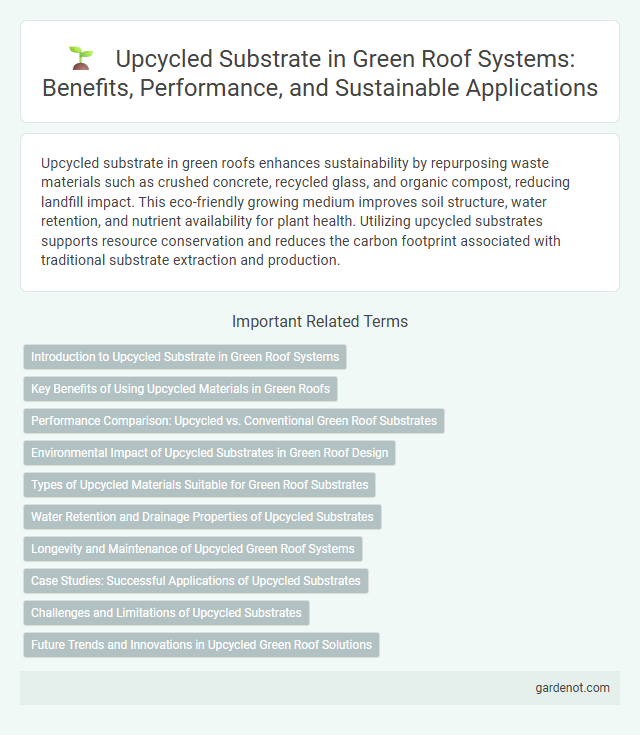Upcycled substrate in green roofs enhances sustainability by repurposing waste materials such as crushed concrete, recycled glass, and organic compost, reducing landfill impact. This eco-friendly growing medium improves soil structure, water retention, and nutrient availability for plant health. Utilizing upcycled substrates supports resource conservation and reduces the carbon footprint associated with traditional substrate extraction and production.
Introduction to Upcycled Substrate in Green Roof Systems
Upcycled substrates in green roof systems utilize recycled organic and inorganic materials to reduce environmental impact while maintaining plant health and structural integrity. These substrates improve drainage, aeration, and nutrient retention by incorporating materials such as crushed concrete, reclaimed soil, and composted green waste. Employing upcycled substrates promotes sustainability by minimizing landfill waste and conserving natural resources in urban landscaping projects.
Key Benefits of Using Upcycled Materials in Green Roofs
Upcycled substrate in green roofs enhances sustainability by reducing landfill waste and conserving natural resources. These materials improve soil structure, promote healthy plant growth, and increase water retention, which boosts overall roof performance. Incorporating upcycled substrates also lowers installation costs and decreases the environmental footprint of green roofing projects.
Performance Comparison: Upcycled vs. Conventional Green Roof Substrates
Upcycled substrates for green roofs demonstrate enhanced water retention and improved nutrient availability compared to conventional substrates, supporting healthier plant growth and extended roof lifespan. Studies indicate upcycled materials reduce runoff by up to 30%, optimizing stormwater management while lowering environmental impact through waste diversion. Performance metrics such as porosity, bulk density, and thermal insulation show upcycled substrates outperform traditional mixes, contributing to sustainable urban infrastructure.
Environmental Impact of Upcycled Substrates in Green Roof Design
Upcycled substrates in green roof design significantly reduce environmental impact by diverting waste materials like crushed concrete, recycled glass, and organic compost from landfills. These substrates improve soil structure and water retention while lowering the demand for virgin raw materials, thus minimizing resource extraction and carbon emissions. Incorporating upcycled materials enhances green roof sustainability by promoting circular economy principles and reducing the overall ecological footprint.
Types of Upcycled Materials Suitable for Green Roof Substrates
Upcycled substrates for green roofs commonly include recycled crushed brick, expanded clay, and shredded rubber, which enhance drainage and aeration while reducing environmental impact. Organic materials like composted green waste and biochar improve water retention and nutrient availability, fostering healthy plant growth. Utilizing these upcycled materials supports sustainable construction practices and promotes circular economy principles in urban landscaping.
Water Retention and Drainage Properties of Upcycled Substrates
Upcycled substrates in green roofs significantly enhance water retention by incorporating recycled organic materials that increase porosity and moisture-holding capacity. These substrates improve drainage properties by balancing aeration and permeability, preventing waterlogging while maintaining sufficient hydration for plant roots. Optimizing the composition of upcycled materials ensures sustainable water management and reduces runoff in urban environments.
Longevity and Maintenance of Upcycled Green Roof Systems
Upcycled substrates enhance the longevity of green roof systems by improving soil structure and retaining moisture, which reduces the frequency of irrigation and maintenance. These sustainable materials resist compaction and nutrient depletion, ensuring long-term plant health and stability. Maintenance costs decrease as upcycled substrates promote resilience against weather extremes and support biodiversity, extending the green roof's functional lifespan.
Case Studies: Successful Applications of Upcycled Substrates
Case studies of upcycled substrates in green roofs demonstrate significant improvements in sustainability by reducing landfill waste and enhancing plant growth through nutrient-rich, recycled materials. Projects using crushed recycled concrete and organic compost have reported increased water retention and root development, leading to longer-lasting, eco-friendly green roof installations. These successful applications highlight the potential of upcycled substrates to lower environmental impact while promoting urban biodiversity and resilience.
Challenges and Limitations of Upcycled Substrates
Upcycled substrates for green roofs often face challenges such as inconsistent material quality and potential contamination, which can affect plant health and soil stability. Limited nutrient availability and poor water retention in some upcycled materials may reduce vegetation growth and increase irrigation needs. Furthermore, regulatory restrictions and lack of standardized testing protocols hinder widespread adoption and commercial scaling of upcycled substrates in green roofing projects.
Future Trends and Innovations in Upcycled Green Roof Solutions
Future trends in upcycled green roof substrates emphasize the integration of biodegradable materials and advanced composite blends to enhance water retention and nutrient delivery. Innovations are leaning toward smart substrates embedded with sensors to monitor plant health and substrate moisture levels in real-time. The increased adoption of circular economy principles drives development of sustainable, high-performance upcycled materials derived from construction waste and agricultural byproducts.
Upcycled substrate Infographic

 gardenot.com
gardenot.com